Underwater robotic machine “BIOSwimmer” - electronic tuna

When you first look at the underwater vehicle, its similarity with the famous sea fish - tuna is immediately striking. Tuna is not chosen by chance - the body structure of the fish provides it with maximum maneuverability when moving under water. The main purpose of the PWS "BIOSwimmer" is to combat smuggling and to ensure the security of the ports and ports of the United States.
After the 2011 year of September, the Department of National Security took under enhanced control the movement of people and goods into the United States. Of particular concern to the DNB is the situation in the seaports of the country. So, in 2010, only one port in Los Angeles received more than 6.5 thousands of twenty-foot sea containers. To exercise complete control and security among such a volume of cargo is extremely difficult. It is expensive and difficult to inspect every container and every ship. The new "BIOSwimmer" unit is designed to facilitate security and non-penetration of smuggling.
Start of development in 2009. Development was carried out by the Advanced Systems Group Boston Engineering Corporation and created the GhostSwimmer prototype. The project was funded by the Department of Homeland Security, and $100 was allocated during the project phase. It is shaped like a fish and has enhanced underwater mobility. According to the designers, the choice of the shape of the tuna is obvious - “why look for the best solution for creating an underwater droneif nature has already done it for us.”
Creation of a new underwater Robot allows you to easily access the ship structure below the waterline, inspect holds and ballast tanks, even in high viscosity liquids such as oil. It will carry out patrols in the open waters of the harbor and water areas, check the underwater parts of berths and docks using installed sensors and radar. Detachable type BIOSwimmer sensors allow it to be used for various tactical tasks. It can be optimized for each task separately. The operator can transmit the general search direction over the data link using a laptop. Systems for communication with the operator, control and work with data received from sensors and radars are installed on board the underwater drone. To perform maneuvers under water, like its prototype - tuna fish, it is provided with a flexible tail, fins, lateral, dorsal and ventral rudders.

The first phase of the tuna robot test has already been successfully completed, and the second phase of the PW BIOSwimmer test has passed since last year. The head of the developer’s company hopes that in addition to the underwater drone version, a commercial version for use in the oil industry will be widely used to ensure the safety of the harbor and maritime shipping.
Information sources:
http://gizmodo.com/bioswimmer/
http://www.tgdaily.com/security-features/66321-dhs-wants-robotic-tuna
http://mport.bigmir.net/war/1525620-Boevoj-tunec--novyj-kiborg-iz-SShA
Information